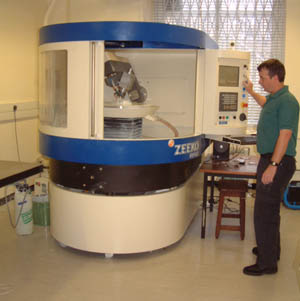Computer Controlled Polishing of Modest-sized Aspherics
| Production Technology for Small to Medium Aspherics Aspherics confer substantial advantages to the optical designer, permitting more highly-corrected imaging performance to be achieved with fewer optical surfaces, in more compact and lower mass packages, and with improved stray light. However, the take-up of aspherics in optical instrumentation systems and consumer products has been restricted by the difficulty, time and cost of producing the aspheric surfaces by the traditional craft process. Diamond turning and grinding have made great strides, but are still not at the stage where high-quality optics for the visible and UV can be produced routinely and directly. This is particularly so in the moderate sizes demanded by many sectors, such as defense, photolithography and cine. Polishing is required in order to achieve high-quality surface texture. OSL has been addressing the challenges of computer controlled polishing of aspherics for more than ten years, starting out at the large-scale required for astronomical telescopes. At the present however, OSL is concentrating on more modest-sized aspherics, working in close collaboration with the spin-out company Zeeko Ltd. The joint vision is to exploit an innovative and effective technology (under patent protection), in order to make aspherics economical for routine applications, and easier and faster to acquire for demanding applications. The process that has been developed by Zeeko in collaboration with OSL is based on a seven axis CNC machine tool that moves a small-tool polisher over the surface of the part. The tool is novel and produces a near-Gaussian removal profile (‘polishing spot’) of continuously variable width. The manufacturing procedure involves a ‘pre-polish’ stage where a part, for example off a diamond-grinding machine, is polished to preserve its surface-form. This process removes grinding marks and sub-surface damage, and gives an excellent surface texture. The second stage is ‘form correction’. In this stage, the form of the part is measured by e.g. an interferometer or profilometer. The removal profile (‘influence function’) is then characterized experimentally on a sample of the material to be polished. A numerical optimisation method then computes the optimum dwell-times and spot-size to remove the form error. Today, the process addresses rotationally-symmetric surfaces, and code is under development to handle simple departures from axial symmetry such as astigmatism or trefoil. Current work is focused on two main areas. The first is optimization for more difficult and larger axially-symmetric aspheres. The second is to extend the process to non axially-symmetric aspheres and free-form surfaces. At OSL this is being driven by various applications. In particular, i) there are challenging demands in the defense sector, ii) there is a pressing need to automate polishing of complex non-optical surfaces (in particular prosthetic joints), and iii) we are involved in the European Extremely Large Telescope projects, that will need hundreds to thousands of 1-2 meter class off-axis hexagonal mirrors. OSL work in this field is currently sponsored by PPARC, EPSRC and DTI. Further information on the Zeeko process may be found at www.zeeko.co.uk |
|
|
| The IRP-600 at UCL, one of Zeeko's family of machines |
Recent Publications
D.D. Walker, D. Brooks, A. King, R. Freeman, R. Morton,
G. McCavana, S-W Kim
‘The ‘Precessions’ Tooling for Polishing and Figuring Flat, Spherical and
Aspheric Surfaces’
Optics Express, Published by Optical Society of America on http://www.opticsexpress.org/, Vol.
11, issue 8, April 21st 2003, pp958-964
D D Walker, A T H Beaucamp, R G Bingham, D Brooks, R Freeman,
S W Kim, A King, G McCavana , R Morton , D Riley, J Simms
'The Precessions process for efficient production of aspheric optics for
large telescopes and their instrumentation'
Proc. SPIE Astronomical Telescopes and Instrumentation Meeting, Hawaii, August 2002, Vol. 4842
(download word file)
D D Walker, A T H Beaucamp, D Brooks, R Freeman, A King,
G McCavana, R. Morton, D Riley, J Simms
'Novel CNC polishing process for control of form and texture on aspheric
surfaces'
Proc. SPIE 47th Annual Meeting, the International Symposium on Optical Science
and Technology, Seattle,2002, Vol. 4451
(download
word file)
D.D. Walker, D. Brooks, R. Freeman, A. King , G.McCavana,
R. Morton, D. Riley, J. Simms
The First Aspheric Form and Texture Results From a Production Machine Embodying
the Precession Process, San Diego 2001, (download zipped
word file)
